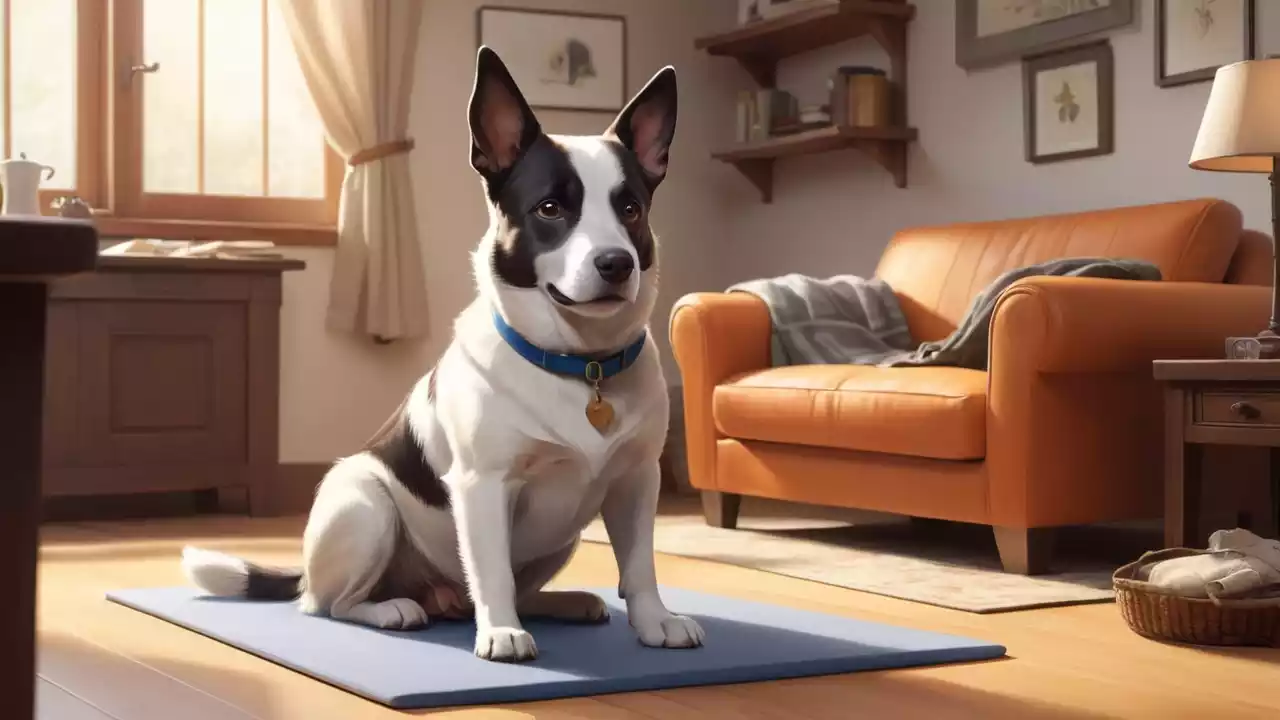
Training a senior dog to use pee pads can be a heartwarming journey filled with patience and compassion. As our beloved canine companions age, they may face challenges with bladder control and mobility, making it crucial to adapt their training needs.
If you’re wondering how to train a senior dog to use pee pads effectively, you’re not alone. Many pet owners are discovering the profound relief and comfort that a well-placed pee pad can offer to their aging dogs.
By providing a consistent, supportive environment, you can help your senior dog feel secure and loved during their golden years. Let’s explore how to make this transition smooth and stress-free for your cherished furry friend.
As our beloved dogs get older, they might have trouble with incontinence or finding the right spot to pee outside. Senior dogs can really benefit from using pee pads. This is true if health issues or changes in how they move make going outside hard.
Training your senior dog to use a pee pad is a great way to keep things clean and easy for them. This guide will show you how to pick the best doggy pads and how to train your senior dog to use them.
Key Takeaways
- Senior dogs may take a few weeks to learn how to use pee pads.
- Consistent scheduled feedings can help reduce indoor accidents.
- Introducing the pee pad multiple times a day is recommended.
- Positive reinforcement is crucial for training senior dogs to use pee pads.
- Punishment can have negative effects and lead to repeated inappropriate behavior.
Choosing the Right Pee Pads for Your Senior Dog
Choosing the right pee pads for your senior dog is key to their comfort and your ease. Disposable pee pads are a top pick because they’re easy to use and throw away. They’re made to soak up a lot and stop leaks and bad smells, which is great for pet owners.
Disposable Pee Pads
Disposable pee pads are great for senior dogs that can’t move easily or live in tall buildings. They make cleaning up after your dog quick and easy, without the need to wash reusable ones.
Reusable Pee Pads
Reusable pee pads are good for the planet and your wallet. They might cost more at first, but you can wash and use them again, cutting down on waste and saving money. Reusable pads like Pet Parents® Pawtect® Pads are made to be washed and reused. They have special features to stop leaks and prevent slipping. Washing them keeps them clean and smelling fresh, making them a good choice for senior dogs.
| Disposable Pee Pads | Reusable Pee Pads |
|---|---|
| Convenient and hassle-free cleanup | Environmentally friendly and cost-effective in the long run |
| Designed for superior absorbency to prevent leaks | Washable and durable for repeated use |
| Hygienic option with no lingering odors | Maintain cleanliness and odor control with regular washing |
Think about what matters most to you and your senior dog when picking pee pads. Look at the benefits and drawbacks of both disposable and reusable options. This way, you can choose what’s best for your pet and your lifestyle.
How to Train a Senior Dog to Use Pee Pads

Getting your senior dog used to pee pads is key. Begin by placing the pad near where they usually go potty. This helps them get to know the pad. Then, pick a spot in your home for the pee pad that’s easy for your dog to get to but not near their food or water bowls. You might also want to put a bit of your dog’s urine on the pad to show it’s for them.
Designate a Pee Pad Area
Keep a regular schedule for your dog’s bathroom breaks. Senior dogs might need to go more often, so take them to the pee pad spot at set times to make a routine. Always watch them during training to catch any accidents and steer them back to the pee pad.
Focus on Consistency and Timing
Give your senior dog treats and praise when they go potty in the right spot. Saying “potty” or “pee” can help them link the action with the command. If they try to pee somewhere else, gently lead them to the right spot and encourage them to go there.
Use Positive Reinforcement
Senior dogs might need more time to get used to new things. Be patient, keep a steady routine, and understand their limits during training. With a steady schedule, positive rewards, and gentle help, your senior dog can learn to use pee pads.
“Positive reinforcement is a powerful tool for shaping and changing a dog’s behavior.”
How to get a senior dog to use pee pads

As our beloved dogs get older, they might have health issues that make going outside hard. Senior dogs might get too tired from walks or struggle to find the right spot. Using indoor pee pads can be a good solution, making it easy and clean for your aging pet.
Training a senior dog to use pee pads takes time and patience, but it can work well. It might take a few weeks for them to learn. To help, set a routine with regular feeding times, and remove the food bowls after 20 minutes to avoid accidents.
Start by letting your dog get used to the pee pads by letting them sniff, paw, and lick them. Pick a specific spot for the pee pads so your dog knows where to go. Reward your dog with praise and treats when they use the pads correctly. Don’t punish them for accidents to avoid fear and hiding, which can make things worse.
Paw Inspired® pee pads use DrySpeed™ Technology for better absorbency. Reusable pee pads are better for the planet and can save money over time. This shows that choosing reusable pads is a smart choice for the environment and wallet.
Senior dogs might need more bathroom breaks, showing they might have more accidents. Using positive reinforcement like treats helps them learn to use the pee pads. Using pet-safe cleaners to get rid of smells is important, showing that accidents can happen during training.
Older dogs often have urinary incontinence. They might take longer to adjust to new routines. If your dog has accidents, see a vet to find out why and how to help. Older dogs can be set in their ways and need patience and consistency in training. A real grass dog toilet can make it easier for them to go when they need to.
By following these tips and using top-quality pee pads like Pet Parents® Pawtect® Pads, you can help your senior dog learn indoor potty training. This makes life easier and cleaner for both of you.
Tips for Transitioning an Older Dog to an Indoor Potty

Switching your older dog to an indoor potty can be easy with some tips. Begin by putting a puppy pad or the outdoor surface your dog likes in their usual spot outside. Then, slowly move it inside. Adding a piece of sod or patio tile to the indoor toilet area can also help your senior dog understand.
Using your dog’s scent, like a soiled paper towel, in the new spot can make them feel at ease. Teaching your dog a potty cue like “go potty” and rewarding them when they go in the right spot helps too.
Training a senior dog to use a pee pad might take time, as they adjust to new habits slowly. Be patient and keep a routine. Feeding your dog on a schedule and taking away their food bowls after 20 minutes can also help prevent accidents.
Introducing the dog to the pee pads by letting them sniff, paw, and lick it is a good idea. Having a specific potty area helps older dogs know where to go. It’s important to reward older dogs for good behavior.
Using top-quality pee pads like Pet Parents® Pawtect® Pads can stop leaks and keep older dogs stable. These pads have features like StickyPaw™ and WickQuick® to prevent slipping and absorb liquids well, saving money on disposable pads.
Cleaning deeply to stop dogs from going in the same spot again and avoiding ammonia-based cleaners can also help. Reusable pee pads like Pet Parents® Pawtect® Pads are good for the planet and save money.
With patience, consistency, and the right tools, you can easily move your older dog to an indoor potty.
🚀 Transform Your Dog’s Behavior with Brain Training for Dogs!
Struggling with your senior dog’s accidents? While pee pad training helps, unlocking your dog’s hidden intelligence can solve behavior issues for good! Adrienne Farricelli’s proven system—developed over 10 years—uses force-free, science-backed methods to:
✔ Eliminate bad behaviors (barking, chewing, reactivity, and more!)
✔ Boost obedience with fun, engaging brain games
✔ Strengthen your bond through positive, gentle training
✔ Tailor solutions to your dog’s unique needs
🌟 Limited-Time Offer: Get the full program + bonuses for just $67 (60-day money-back guarantee!).
👉 Click Here to Access Brain Training for Dogs NOW! 👈
“My dogs are more excited to learn—bad behaviors melted away!” — Rosemary D.
Don’t wait—act today and enjoy a happier, smarter dog! 🐾
Conclusion
Training your senior dog to use a pee pad can be a big help. It makes things easier and cleaner for you and your pet. It might take some time and patience, but the right steps can make it easier for your dog.
Choosing the right pee pads, like those with extra absorbency and reuse, like Paw Inspired® products, is key. A regular schedule, positive rewards, and clear signals can help your dog learn faster.
Senior dogs might need to go outside more often and face special challenges like leg problems or trouble moving around. But, with the right tools and patience, you and your senior dog can make this change work. This leads to a clean and easy solution for their needs.
FAQ
What are the benefits of using pee pads for senior dogs?
Senior dogs may struggle with incontinence or mobility issues. Pee pads offer a convenient and clean solution. They let your older dog go to the bathroom indoors, especially when going outside is hard due to health problems.
How do I choose the best pee pads for my senior dog?
Choosing between disposable and reusable pee pads is up to you. Disposable pads are easy to use and absorb a lot, making cleanup simple. Reusable pads are better for the planet and save money over time, but you need to wash them regularly to keep them clean and fresh.
What is the best way to introduce a pee pad to my senior dog?
Begin by placing the pee pad near where your dog usually goes to the bathroom. This helps them get used to it. You can also put a bit of your pet’s urine on the pad to show them it’s for their use.
How do I establish a consistent routine for my senior dog to use the pee pad?
Choose a specific spot in your home for the pee pad. Take your senior dog there at the same times every day to create a routine. Watching your pet during training helps you catch any accidents and guide them to the pee pad.
How can I use positive reinforcement to encourage my senior dog to use the pee pad?
When your senior dog uses the pee pad, praise them and give a treat. Use commands like “potty” or “pee” to link the action with the command. If your pet tries to pee elsewhere, gently move them to the pee pad.
What are some tips for transitioning an older dog to using an indoor potty?
Begin by putting a puppy pad or the outdoor surface your dog knows in their usual spot. Add your dog’s scent to the area and teach a potty command to help them adjust.






